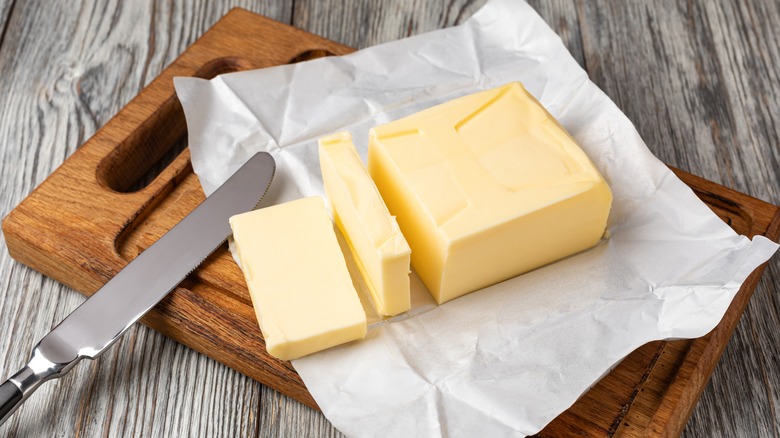Why You Should Always Bake With Full-Fat Butter
Butter is an indispensable element in so many baked goods. But not all butter is created equal. In fact, if you survey the butter section of your grocery store, you may be confounded by the many options. Salted or unsalted. Sticks or tubs. Whipped versions or even some that are infused with flavor. When it comes to baking though, there is one piece of information on the label that will make a major difference, and that's the amount of fat in your butter.
This is critical not only for the flavor and richness that butter brings to your baked goods, but to the composition of your recipes. If you see a percentage of fat printed on the package, this number is an indicator of the product's butterfat, or milk solids. When you have a butter with less butterfat, it means that the remaining percentage is primarily water, and that added liquid can throw off the carefully calibrated formulas upon which your favorite baking recipes are built.
Understanding fat content is among the most important rules for choosing the best butter substitute. And while you may opt to use a low-fat butter or butter spread in other contexts, some of those options come packaged with other ingredients like canola oil and tend to contain other preservatives and artificial flavors that can affect the finished products of your baking projects.
The importance of butterfat
Butterfat is important for other reasons, too. For one, it contributes to the color of your baked goods, giving that signature golden hue to cookies, cakes, croissants, muffins, blondies, and beyond. It also impacts consistency, helping create dreamy textures like tender crumb in your cakes and a melt-in-your-mouth softness in your cookies.
If your store stocks a dizzying amount of butter options and you're not sure which to purchase, you can actually make a judgement call based on your butter's place of origin. The European Union has rules in place that require butter to be no more than 16% water (with a butterfat content between 82% and 90%). On the other hand, producers in the U.S. (88% of which are based in one single state) can make butter with as little as 80% butterfat. Given that legal distinction, when in doubt, you can confidently purchase European-made butter and know that it'll be on the higher end of the butterfat spectrum, even if you don't know the exact percentage.
Not all butter questions are as easily answered. But while you may wonder how much salt is really in salted butter, understanding how much fat is in each of your sticks will help you ensure the best results from your baking recipes.

